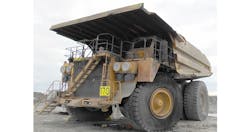Recent truck fires at mining worksites—one of them fatal—caused the Mine Safety and Health Administration (MSHA) to launch a new fire suppression system initiative that includes an educational effort aimed at employers and an order directing agency inspectors to make these systems a priority in future inspections.
MSHA discussed the new initiative during its Oct. 16 quarterly stakeholder conference call, taking note of the recent spate of accidents, including one that was fatal. One month earlier, a miner was burned when a fire broke out on the rock truck he was operating at a coal mine. At the time of the accident, the miner was hauling spoil material from the pit to the dump site.
As he was positioning the truck at the dump site at the Bear Run Mine in Indiana, a bulldozer operator saw a fire near the engine compartment and operator’s cab. The bulldozer operator radioed the miner operating the truck. After stopping the truck, the miner evacuated but received burns as he traveled down the stairs which are beside the engine compartment.
The miner was transported to a hospital and a burn center for treatment, but he died from his injuries five days after the accident took place.
During the investigation, MSHA checked the truck’s manually-activated fire suppression system. Based on statements made during the investigation, the fire suppression system failed to function when it was activated. “A properly functioning fire suppression system may have saved this miner’s life,” MSHA said.
About two weeks later, two more fires occurred. A fire also took place at the same mine on another rock truck of the same make and model. No one was injured, but again, based on statements, the manually-activated fire suppression system did not function when the drivers attempted to activate it.
In yet another case, a non-injury fire also occurred on a hydraulic shovel. In that situation the automatic fire suppression system activated but it did not extinguish the fire.
“It is the responsibility of mine operators to ensure that adequate and effective fire protection equipment, which includes fire suppression systems, is provided,” MSHA stressed. “Also, it’s the responsibility of mine operators and miners to ensure that fire hazards on surface vehicles are adequately eliminated and/or mitigated.”
MSHA said its personnel will look at fire suppression systems on these types of surface mining vehicles when they visit surface mining sites. They will check critical portions of fire suppression systems and will discuss key requirements of proper installation and maintenance of these systems with managers and workers on site.
The agency reminds operators that fully compliant systems adhere to the requirements in National Fire Protection Association (NFPA) 17 and 17A (Standards for Dry and Wet Chemical Extinguishing Systems), the system manufacturer’s recommendations, as well as the 30 CFR regulations.
As part of the fire suppression initiative, the agency is stressing the importance of periodic and detailed maintenance, review of evacuation/egress methods, adequate task training for vehicle operators, and detailed review of the fire suppression system owner’s manual. MSHA also said that it wants operators to contact manufacturers when necessary and check their fire suppression systems to ensure they will operate in case of a fire.
“If a fire does ignite, it is imperative that miners have a means to dismount equipment quickly and safely,” MSHA said. It encourages manufacturers of surface vehicles, as well as mine operators, to develop and install evacuation methods that allow a miner to stay away from areas of the vehicle where, historically, fires have started, including the engine and battery compartments and hydraulic hoses.
MSHA has prepared a PowerPoint training presentation and a checklist that will be used by inspectors on enforcement visits and which also can be used by the mining community to help evaluate fire suppression systems. It will be posted on our website. Thorough pre-operational examinations and required maintenance are critical to finding and removing fire hazards related to combustible fluids, brake systems, electrical cables and connections, and other materials.
“Adequate task training must be performed so equipment operators and mechanics will be able to maintain equipment, respond correctly to alarms, use fire suppression systems properly and safely dismount equipment in an emergency,” the agency said. In addition, it said mine operators should provide refresher training for their employees as needed.
During the quarterly stakeholders call, MSHA officials also reviewed the agency’s Powered Haulage Safety Initiative and reiterated its importance, stating that over 50% of mine-related fatalities in 2018 involved powered haulage. The power haulage initiative is focused on large mobile equipment safety, seat belt usage and conveyor safety.
The third of these topics—conveyor safety—is the current emphasis of the agency, with guarding, lockout/tagout and safe access during maintenance checks of particular interest, noted attorney Lauren M. Marino of the Ogletree Deakins law firm. In order to address this issue, MSHA has created brochures and other materials for inspectors and compliance assistance.
About the Author

David Sparkman
David Sparkman is founding editor of ACWI Advance, the newsletter of the American Chain of Warehouses Inc. He also heads David Sparkman Consulting, a Washington, D.C. area public relations and communications firm. Prior to these he was director of industry relations for the International Warehouse Logistics Association. Sparkman has also been a freelance writer, specializing in logistics and freight transportation. He has served as vice president of communications for the American Moving and Storage Association, director of communications for the National Private Truck Council, and for two decades with American Trucking Associations on its weekly newspaper, Transport Topics.
